George Washington
From Wikipedia, the free encyclopedia
This article is about the first President of the United States. For other uses, see George Washington (disambiguation).
| His Excellency General of the Armies George Washington | |
|---|---|
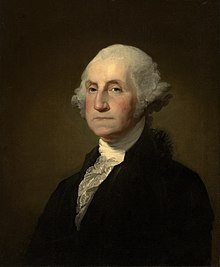
George Washington by Gilbert Stuart, 1797
| |
| 1st President of the United States | |
| In office April 30, 1789[a] – March 4, 1797 | |
| Vice President | John Adams |
| Preceded by | Inaugural holder |
| Succeeded by | John Adams |
| Senior Officer of the Army | |
| In office July 13, 1798 – December 14, 1799 | |
| Appointed by | John Adams |
| Preceded by | James Wilkinson |
| Succeeded by | Alexander Hamilton |
| Commander-in-Chief of the Continental Army | |
| In office June 15, 1775 – December 23, 1783 | |
| Appointed by | Continental Congress |
| Preceded by | Inaugural holder |
| Succeeded by | Henry Knox (Senior Officer of the Army) |
| Delegate to the Second Continental Congress from Virginia | |
| In office May 10, 1775 – June 15, 1775 | |
| Preceded by | Inaugural holder |
| Succeeded by | Thomas Jefferson |
| Delegate to the First Continental Congress from Virginia | |
| In office September 5, 1774 – October 26, 1774 | |
| Preceded by | Inaugural holder |
| Succeeded by | Position abolished |
| Personal details | |
| Born | February 22, 1732 Westmoreland County,Virginia, British America |
| Died | December 14, 1799 (aged 67) Mount Vernon, Virginia,United States of America |
| Resting place | Washington Family Tomb Mount Vernon, Virginia |
| Political party | None |
| Spouse(s) | Martha Dandridge (m. 1759; his death 1799) |
| Religion | Episcopal Church[1][2] or Deism[3] |
| Awards | Congressional Gold Medal Thanks of Congress |
| Signature | |
| Military service | |
| Allegiance | |
| Service/branch | |
| Years of service | British Militia: 1752–58 Continental Army: 1775–83 U.S. Army: 1798–99 |
| Rank | |
| Commands | Virginia Colony's regiment Continental Army United States Army |
| Battles/wars | |
 | This article is part of a series about George Washington |
|---|---|
|
President of the United States
First term
Second term
| |
George Washington (February 22, 1732 [O.S. February 11, 1731][b][c] – December 14, 1799) was the first President of the United States (1789–97), the Commander-in-Chief of the Continental Army during the American Revolutionary War, and one of theFounding Fathers of the United States. He presided over the convention that drafted the current United States Constitution and during his lifetime was called the "father of his country".[4]
Widely admired for his strong leadership qualities, Washington was unanimously elected President in the first two national elections. He oversaw the creation of a strong, well-financed national government that maintained neutrality in the French Revolutionary Wars, suppressed the Whiskey Rebellion, and won acceptance among Americans of all types.[5] Washington's incumbency established many precedents, still in use today, such as the cabinet system, the inaugural address, and the title Mr. President.[6][7] His retirement from office after two terms established a tradition that lasted until 1940, when Franklin Delano Roosevelt won an unprecedented third term.
Born into the provincial gentry of Colonial Virginia, his family were wealthy planters who owned tobacco plantations and slaves which he inherited. He owned hundreds of slaves throughout his lifetime, but his views on slavery evolved. In his youth he became a seniorBritish officer in the colonial militia during the first stages of the French and Indian War. In 1775 the Second Continental Congresscommissioned Washington as commander-in-chief of the Continental Army in the American Revolution. In that command, Washington forced the British out of Boston in 1776, but was defeated and nearly captured later that year when he lost New York City. After crossing the Delaware River in the middle of winter, he defeated the British in two battles (Trenton and Princeton), retook New Jersey and restored momentum to the Patriot cause.
His strategy enabled Continental forces to capture two major British armies at Saratoga in 1777 and Yorktown in 1781. Historians laud Washington for the selection and supervision of his generals, preservation and command of the army, coordination with the Congress, with state governors and their militia, and attention to supplies, logistics, and training. In battle, however, Washington was repeatedly outmaneuvered by British generals with larger armies. After victory had been finalized in 1783, Washington resigned as commander-in-chief rather than seize power, proving his opposition to dictatorship and his commitment to American republicanism.[8]
Washington presided over the Constitutional Convention in 1787, which devised a new form of federal government for the United States. Following unanimous election as President in 1789, he worked to unify rival factions in the fledgling nation. He supportedAlexander Hamilton's programs to satisfy all debts, federal and state, established a permanent seat of government, implemented an effective tax system, and created a national bank.[9] In avoiding war with Great Britain, he guaranteed a decade of peace and profitable trade by securing the Jay Treaty in 1795, despite intense opposition from the Jeffersonians. Although he remained nonpartisan, never joining the Federalist Party, he largely supported its policies. Washington's Farewell Address was an influential primer on republican virtue, warning against partisanship, sectionalism, and involvement in foreign wars. He retired from the presidency in 1797, returning to his home and plantation at Mount Vernon.
While in power, his use of national authority pursued many ends, especially the preservation of liberty, reduction of regional tensions, and promotion of a spirit of American nationalism.[10] Upon his death, Washington was eulogized as "first in war, first in peace, and first in the hearts of his countrymen" by Henry Lee.[11] Revered in life and in death, scholarly and public pollingconsistently ranks him among the top three presidents in American history; he has been depicted and remembered in monuments, currency, and other dedications to the present day.
Contents
[hide]- 1Early life (1732–1753)
- 2French and Indian War (or 'Seven Years' War', 1754–1758)
- 3Between the wars: Mount Vernon (1759–1774)
- 4American Revolution (1775–1783)
- 5Constitutional Convention
- 6Presidency (1789–1797)
- 7Retirement (1797–1799)
- 8Death
- 9Legacy
- 10Personal life
- 11Postage and currency
- 12See also
- 13Notes
- 14References
- 15Bibliography
- 16External links
Early life (1732–1753)
Further information: Ancestry of George Washington
The first child of Augustine Washington (1694–1743) and his second wife, Mary Ball Washington (1708–1789), George Washington was born on their Pope's Creek Estate near present-day Colonial Beach in Westmoreland County, Virginia. According to the Julian calendar and Annunciation Style of enumerating years (then in use in the British Empire), Washington was born on February 11, 1731; the Gregorian calendar, adopted later within the British Empire in 1752, renders a birth date of February 22, 1732.[12][b][c]
Washington was of primarily English gentry descent, especially from Sulgrave, England. His great-grandfather, John Washington, emigrated to Virginia in 1656 and began accumulating land and slaves, as did his son Lawrence and his grandson, George's father, Augustine. Augustine was a tobacco planter who also tried his hand in iron-mining ventures.[13] In George's youth, the Washingtons were moderately prosperous members of the Virginiagentry, of "middling rank" rather than one of the leading planter families.[14] At this time, Virginia and other southern colonies had become a slave society, in which slaveholders formed the ruling class and the economy was based upon slave labor.[15]
Six of George's siblings reached maturity, including two older half-brothers, Lawrence and Augustine, from his father's first marriage to Jane Butler Washington, and four full siblings, Samuel, Elizabeth (Betty), John Augustine and Charles. Three siblings died before adulthood: his full sister Mildred died when she was about one, his half-brother Butler died in infancy,[16] and his half-sister Jane died aged of twelve, when George was about two.[17] His father died of a sudden illness in April 1743 when George was eleven years old, and his half-brother Lawrence became a surrogate father and role model. William Fairfax, Lawrence's father-in-law and cousin of Virginia's largest landowner, Thomas, Lord Fairfax, was also a formative influence.
Washington spent much of his boyhood at Ferry Farm in Stafford County near Fredericksburg. Lawrence Washington inherited another family property from his father, a plantation on the Potomac River at Little Hunting Creek, which he named Mount Vernon, in honor of his commanding officer, Admiral Edward Vernon. George inherited Ferry Farm upon his father's death and eventually acquired Mount Vernon after Lawrence's death.[18]
The death of his father prevented Washington from an education at England's Appleby School, as his older brothers had received. He achieved the equivalent of an elementary school education from a variety of tutors, as well as from school run by an Anglican clergyman in or near Fredericksburg.[20][21] Talk of securing an appointment in the Royal Navy for him when he was 15 was dropped when his widowed mother objected.[22] Thanks to Lawrence's connection to the powerful Fairfax family, at age 17 in 1749, Washington was appointed official surveyor for Culpeper County, a well-paid position which enabled him to purchase land in theShenandoah Valley, the first of his many land acquisitions in western Virginia. Thanks also to Lawrence's involvement in the Ohio Company, a land investment company funded by Virginia investors, and Lawrence's position as commander of the Virginia militia, Washington came to the notice of the new lieutenant governor of Virginia, Robert Dinwiddie. Washington was hard to miss: At exactly six feet, he towered over most of his contemporaries.[23]
In 1751 Washington traveled to Barbados with Lawrence, who was suffering from tuberculosis, with the hope that the climate would be beneficial to Lawrence's health. Washington contracted smallpox during the trip, which left his face slightly scarred, but immunized him against future exposures to the dreaded disease.[24] However, Lawrence's health failed to improve, and he returned to Mount Vernon, where he would die in the summer of 1752.[25]Lawrence's position as Adjutant General (militia leader) of Virginia was divided into four district offices after his death. Washington was appointed by Governor Dinwiddie as one of the four district adjutants in February 1753, with the rank of major in the Virginia militia.[26] During this period, Washington became a Freemason while in Fredericksburg, although his involvement was minimal.[27]
French and Indian War (or 'Seven Years' War', 1754–1758)
Main article: George Washington in the French and Indian War
See also: Military career of George Washington, Battle of Jumonville Glen, Battle of Fort Necessity and Forbes Expedition
The Ohio Company was an important vehicle through which British investors planned to expand into the Ohio Valley, opening new settlements and trading posts for the Indian trade.[28] In 1753 the French themselves began expanding their military control into the Ohio Country, a territory already claimed by the British colonies of Virginia and Pennsylvania. These competing claims led to a war in the colonies called the French and Indian War (1754–62), and contributed to the start of the global Seven Years' War (1756–63). By chance, Washington became involved in its beginning.
Robert Dinwiddie, lieutenant governor of colonial Virginia, was ordered by the British government to guard the British territorial claims including theOhio River basin. In late 1753 Dinwiddie ordered Washington to deliver a letter asking the French to vacate the Ohio Valley;[28] he was eager to prove himself as the new adjutant general of the militia, appointed by the Lieutenant Governor himself only a year before. During his trip Washington met with Tanacharison (also called "Half-King") and other Iroquois chiefs allied with England at Logstown to secure their support in case of a military conflict with the French—indeed Washington and Tanacharison became friends. He delivered the letter to the local French commander Jacques Legardeur de Saint-Pierre, who politely refused to leave.[29] Washington kept a diary during his expedition which was printed by William Hunter on Dinwiddie's order and which made Washington's name recognizable in Virginia.[30] This increased notoriety helped him to obtain a commission to raise a company of 100 men and start his military career.[31]
Dinwiddie sent Washington back to the Ohio Country to safeguard an Ohio Company's construction of a fort at present-day Pittsburgh, Pennsylvania. However, before he reached the area, a French force drove out colonial traders and began construction of Fort Duquesne. A small detachment of French troops led by Joseph Coulon de Jumonville, was discovered by Tanacharison and a few warriors east of present-day Uniontown, Pennsylvania. On May 28, 1754, Washington and some of his militia unit, aided by their Mingo allies, ambushed the French in what has come to be called the Battle of Jumonville Glen. Exactly what happened during and after the battle is a matter of contention, but several primary accounts agree that the battle lasted about 15 minutes, that Jumonville was killed, and that most of his party were either killed or taken prisoner. Whether Jumonville died at the hands of Tanacharison in cold blood or was somehow shot by an onlooker with a musket as he sat with Washington or by another means, is not completely clear.[32][33] He was given the epithet Town Destroyer by Tanacharison.[34]
The French responded by attacking and capturing Washington at Fort Necessity in July 1754.[35] However, he was allowed to return with his troops to Virginia. Historian Joseph Ellis concludes that the episode demonstrated Washington's bravery, initiative, inexperience and impetuosity.[36] These events had international consequences; the French accused Washington of assassinating Jumonville, who they claimed was on a diplomatic mission.[36]Both France and Great Britain were ready to fight for control of the region and both sent troops to North America in 1755; war was formally declared in 1756.[37]
Braddock disaster 1755
Main article: Braddock Expedition
In 1755 Washington became the senior American aide to British General Edward Braddock on the ill-fated Braddock expedition. This was the largest British expedition to the colonies, and was intended to expel the French from the Ohio Country; the first objective was the capture of Fort Duquesne.[38] Washington initially sought an appointment as a major from Braddock, but upon advice that no rank above captain could be given except by London, he agreed to serve as a staff volunteer. During the passage of the expedition, Washington fell ill with severe headaches and fever; nevertheless, when the pace of the troops continued to slow, Washington recommended to Braddock that the army be split into two divisions – a primary and more lightly, but adequately equipped, "flying column" offensive which could move at a more rapid pace, to be followed by a more heavily armed reinforcing division. Braddock accepted the recommendation (likely made in a council of war including other officers) and took command of the lead division.[39][40]
In the Battle of the Monongahela the French and their Indian allies ambushed Braddock's reduced forces and the general was mortally wounded. After suffering devastating casualties, the British panicked and retreated in disarray; however, Washington rode back and forth across the battlefield, rallying the remnants of the British and Virginian forces into an organized retreat. In the process, despite his lingering illness, he demonstrated much bravery and stamina—he had two horses shot from underneath him, while his coat was pierced with four bullets. In his report, Washington chiefly blamed the disaster on the conduct of the redcoats while praising that of the Virginia contingent. Whatever responsibility rested on him for the defeat as a result of his recommendation to Braddock, Washington was not included by the succeeding commander, Col. Thomas Dunbar, in planning subsequent force movements.[41]
Commander of Virginia Regiment
Lt. Governor Dinwiddie rewarded Washington in 1755 with a commission as "Colonel of the Virginia Regiment and Commander in Chief of all forces now raised in the defense of His Majesty's Colony" and gave him the task of defending Virginia's frontier. The Virginia Regiment was the first full-time American military unit in the colonies (as opposed to part-time militias and the British regular units). Washington was ordered to "act defensively or offensively" as he thought best.[42] While Washington happily accepted the commission, the coveted redcoat of a British officer as well as the accompanying pay continued to elude him. Dinwiddie as well pressed in vain for the British military to incorporate the Virginia regiment into its ranks.[43]
In command of a thousand soldiers, Washington was a disciplinarian who emphasized training. He led his men in brutal campaigns against the Indians in the west; in 10 months his regiment fought 20 battles, and lost a third of its men. Washington's strenuous efforts meant that Virginia's frontier population suffered less than that of other colonies; Ellis concludes "it was his only unqualified success" in the war.[44][45]
In 1758 Washington participated in the Forbes Expedition to capture Fort Duquesne. He was embarrassed by a friendly fire episode in which his unit and another British unit thought the other was the French enemy and opened fire, with 14 dead and 26 wounded in the mishap. Washington was not involved in any other major fighting on the expedition, and the British scored a major strategic victory, gaining control of the Ohio Valley, when the French abandoned the fort. Following the expedition, he retired from his Virginia Regiment commission in December 1758. Washington did not return to military life until the outbreak of the revolution in 1775.[46]
Lessons learned
Although Washington never gained the commission in the British army he yearned for, in these years the young man gained valuable military, political, and leadership skills.[47][48]He closely observed British military tactics, gaining a keen insight into their strengths and weaknesses that proved invaluable during the Revolution. Washington learned to organize, train, drill, and discipline his companies and regiments. From his observations, readings and conversations with professional officers, he learned the basics of battlefield tactics, as well as a good understanding of problems of organization and logistics.[49] He gained an understanding of overall strategy, especially in locating strategic geographical points.[50]
He demonstrated his toughness and courage in the most difficult situations, including disasters and retreats. He developed a command presence—given his size, strength, stamina, and bravery in battle, he appeared to soldiers to be a natural leader and they followed him without question.[51][52] However Washington's fortitude in his early years was sometimes manifested in less constructive ways. Biographer John R. Alden contends Washington offered "fulsome and insincere flattery to British generals in vain attempts to win great favor" and on occasion showed youthful arrogance, as well as jealousy and ingratitude in the midst of impatience.[53]
Historian Ron Chernow is of the opinion that his frustrations in dealing with government officials during this conflict led him to advocate the advantages of a strong national government and a vigorous executive agency that could get results;[47] other historians tend to ascribe Washington's position on government to his later American Revolutionary War service.[d] He developed a very negative idea of the value of militia, who seemed too unreliable, too undisciplined, and too short-term compared to regulars.[54] On the other hand, his experience was limited to command of at most 1000 men, and came only in remote frontier conditions that were far removed from the urban situations he faced during the Revolution at Boston, New York, Trenton and Philadelphia.[55]
Between the wars: Mount Vernon (1759–1774)
On January 6, 1759, Washington married the wealthy widow Martha Dandridge Custis, then 28 years old. Surviving letters suggest that he may have been in love at the time with Sally Fairfax, the wife of a friend.[56] Nevertheless, George and Martha made a compatible marriage, because Martha was intelligent, gracious, and experienced in managing a planter's estate.[57]
Together the two raised her two children from her previous marriage, John Parke Custis and Martha Parke Custis; later the Washingtons raised two of Mrs. Washington's grandchildren, Eleanor Parke Custis andGeorge Washington Parke Custis. George and Martha never had any children together—his earlier bout with smallpox in 1751 may have made him sterile.[58][59] The newlywed couple moved to Mount Vernon, near Alexandria, where he took up the life of a planter and political figure.
Washington's marriage to Martha greatly increased his property holdings and social standing, and made him one of Virginia's wealthiest men. He acquired one-third of the 18,000-acre (73 km2) Custis estate upon his marriage, worth approximately $100,000, and managed the remainder on behalf of Martha's children, for whom he sincerely cared.[60]
In 1754 Lieutenant Governor Dinwiddie had promised land bounties to the soldiers and officers who volunteered to serve during the French and Indian War.[61] Lord Botetourt, the new governor, finally fulfilled Dinwiddie's promise in 1769–1770,[61][62] with Washington subsequently receiving title to 23,200 acres (94 km2) where the Kanawha River flows into the Ohio River, in what is now western West Virginia.[63] He also frequently bought additional land in his own name. By 1775 Washington had doubled the size of Mount Vernon to 6,500 acres (26 km2), and had increased its slave population to over 100. As a respected military hero and large landowner, he held local office and was elected to the Virginia provincial legislature, representing Frederick County in the House of Burgesses for seven years, beginning in 1758.[64][e]
Washington lived an aristocratic lifestyle—fox hunting was a favorite leisure activity.[65] He also enjoyed going to dances and parties, in addition to the theater, races, and cockfights. Washington also was known to play cards, backgammon, and billiards.[66] Like most Virginia planters, he imported luxuries and other goods from England and paid for them by exporting his tobacco crop.[67]
Washington began to pull himself out of debt in the mid-1760s by diversifying his previously tobacco-centric business interests into other ventures[67] and paying more attention to his affairs.[68] In 1766 he started switching Mount Vernon's primary cash crop away from tobacco to wheat, a crop that could be processed and then sold in various forms in the colonies, and further diversified operations to include flour milling, fishing, horse breeding, spinning, weaving and (in the 1790s) whiskey production.[67] Patsy Custis's death in 1773 from epilepsy enabled Washington to pay off his British creditors, since half of her inheritance passed to him.[69]
A successful planter, he was a leader in the social elite in Virginia. From 1768 to 1775, he invited some 2000 guests to his Mount Vernon estate, mostly those he considered "people of rank". As for people not of high social status, his advice was to "treat them civilly" but "keep them at a proper distance, for they will grow upon familiarity, in proportion as you sink in authority".[70] In 1769 he became more politically active, presenting the Virginia Assembly with legislation to ban the importation of goods from Great Britain.[71]
American Revolution (1775–1783)
Main articles: George Washington in the American Revolution and Military career of George Washington
Washington opposed the 1765 Stamp Act, the first direct tax on the colonies imposed by the English Parliament which included no representatives from the colonies; he began taking a leading role in the growing colonial resistance when protests against the Townshend Acts (enacted in 1767) became widespread. In May 1769 Washington introduced a proposal, drafted by his friend George Mason, calling for Virginia to boycott English goods until the Acts were repealed.[72] Parliament repealed the Townshend Acts in 1770. However, Washington regarded the passage of the Intolerable Acts in 1774 as "an Invasion of our Rights and Privileges".[73] Washington told friend Bryan Fairfax, "I think the Parliament of Great Britain has no more right to put their hands in my pocket without my consent than I have to put my hands into yours for money." He also said that Americans must not submit to acts of tyranny "till custom and use shall make us as tame and abject slaves, as the blacks we rule over with such arbitrary sway."[74]
In July 1774 he chaired the meeting at which the "Fairfax Resolves" were adopted, which called for the convening of a Continental Congress, among other things. In August, Washington attended the First Virginia Convention, where he was selected as a delegate to the First Continental Congress.[75][76]
Commander in chief
After the Battles of Lexington and Concord near Boston in April 1775, the colonies went to war. Washington appeared at the Second Continental Congress in a military uniform, signaling that he was prepared for war.[77] Washington had the prestige, military experience, charisma and military bearing of a military leader and was known as a strong patriot. Virginia, the largest colony, deserved recognition, and New England—where the fighting began—realized it needed Southern support. Washington did not explicitly seek the office of commander and said that he was not equal to it,[78][79] but there was no serious competition.[80] Congress created the Continental Army on June 14, 1775.[81] Nominated by John Adams of Massachusetts, Washington was then appointed as a full General and Commander-in-chief.[78][82][83] The British then articulated the peril of Washington and his army—on August 23, 1775 Britain issued a Royal proclamation labeling American rebels as traitors; if they resorted to force, they faced confiscation of their property. Their leaders were subject to execution upon the scaffold.[84]
General Washington essentially assumed three roles during the war. First, in 1775–77, and again in 1781 he provided leadership of troops against the main British forces. Although he lost many of his battles, he never surrendered his army during the war, and he continued to fight the British relentlessly until the war's end. He plotted the overall strategy of the war, in cooperation with Congress.[85]
Secondly, he was charged with organizing and training the army. He recruited regulars and assigned Baron von Steuben, a veteran of the Prussian general staff, to train them. The war effort and getting supplies to the troops were under the purview of Congress,[86] but Washington pressured the Congress to provide the essentials.[87] In June 1776 Congress' first attempt at running the war effort was established with the committee known as "Board of War and Ordnance", succeeded by the Board of War in July 1777, a committee which eventually included members of the military.[86] The command structure of the armed forces was a hodgepodge of Congressional appointees (and Congress sometimes made those appointments without Washington's input) with state-appointments filling the lower ranks and of all of the militia-officers. The results of his general staff were mixed, as some of his favorites (like John Sullivan) never mastered the art of command.[85]
Eventually, he found capable officers, such as General Nathanael Greene, General Daniel Morgan - "the old wagoner" that he had served with inThe French and Indian War, Colonel Henry Knox - chief of artillery, and Colonel Alexander Hamilton - chief-of-staff. The American officers never equaled their opponents in tactics and maneuver, and consequently they lost most of the pitched battles. The great successes, at Boston (1776),Saratoga (1777) and Yorktown (1781), came from trapping the British far from base with much larger numbers of troops.[85] Daniel Morgan's annihilation of Banastre Tarleton's legion of dragoons at Cowpens in February 1781, came as a result of Morgan's employment of superior line tactics against his British opponent, resulting in one of the very few double envelopments in military history, another being Hannibal's defeat of the Romans at Cannae in 216 b.c. The decisive defeat of Col. Patrick Ferguson's Tory Regiment at King's Mountain demonstrated the superiority of the riflery of American "over mountain men" over British-trained troops armed with musket and bayonet. These "over-mountain men" were led by a variety of elected officers, including the 6'6" William Campbell who had become one of Washington's officers by the time of Yorktown. Similarly, Morgan's Virginia riflemen proved themselves superior to the British at Saratoga, a post-revolutionary war development being the creation of trained "rifle battalions" in the European armies.
Washington's third, and most important role in the war effort, was the embodiment of armed resistance to the Crown—the representative man of the Revolution. His long-term strategy was to maintain an army in the field at all times, and eventually this strategy worked. His enormous personal and political stature and his political skills kept Congress, the army, the French, the militias, and the states all pointed toward a common goal. Furthermore, by voluntarily resigning his commission and disbanding his army when the war was won (rather than declaring himself monarch), he permanently established the principle of civilian supremacy in military affairs. Yet his constant reiteration of the point that well-disciplined professional soldiers counted for twice as much as erratic militias (clearly demonstrated in the rout at Camden, where only the Maryland and Delaware Continentals under Baron DeKalb held firm), helped overcome the ideological distrust of a standing army.[88]
Victory at Boston
Washington assumed command of the Continental Army in the field at Cambridge, Massachusetts, in July 1775, during the ongoing siege of Boston. Realizing his army's desperate shortage of gunpowder, Washington asked for new sources. American troops raided British arsenals, including some in the Caribbean, and some manufacturing was attempted. They obtained a barely adequate supply (about 2.5 million pounds) by the end of 1776, mostly from France.[89]
Washington reorganized the army during the long standoff, and forced the British to withdraw by putting artillery on Dorchester Heightsoverlooking the city. The British evacuated Boston in March 1776 and Washington moved his army to New York City.[90]
Although highly disparaging toward most of the Patriots, British newspapers routinely praised Washington's personal character and qualities as a military commander. These articles were bold, as Washington was an enemy general who commanded an army in a cause that many Britons believed would ruin the empire.[91]
Defeat at New York City and Fabian tactics
In August 1776 British General William Howe launched a massive naval and land campaign designed to seize New York. The Continental Army under Washington engaged the enemy for the first time as an army of the newly independent United States at the Battle of Long Island, the largest battle of the entire war. The Americans were heavily outnumbered, many men deserted, and Washington was badly beaten. Subsequently, Washington was forced to retreat across the East River at night. He did so without loss of life or materiel.[92]Washington, heeding Greene's recommendation to attempt a defense of Ft. Washington, belatedly retreated further across the Hudson to Ft. Lee, to avoid encirclement, but thereby enabled Howe to take the offensive and capture Fort Washington on November 16 with high Continental casualties. Biographer Alden opines that "although Washington was responsible for the decision to delay the patriots' retreat, he tried to ascribe blame for the decision to defend Fort Washington to the wishes of Congress and the bad advice of Nathaniel Greene."[93]
Washington then continued his flight across New Jersey; the future of the Continental Army was in doubt due to expiring enlistments and the string of losses.[94] On the night of December 25, 1776, Washington staged a comeback with a surprise attack on a Hessian outpost in western New Jersey. He led his armyacross the Delaware River to capture nearly 1,000 Hessians in Trenton, New Jersey. Washington followed up his victory at Trenton with another over British regulars at Princetonin early January. The British retreated to New York City and its environs, which they held until the peace treaty of 1783. Washington's victories wrecked the British carrot-and-stick strategy of showing overwhelming force then offering generous terms. The Americans would not negotiate for anything short of independence.[95] These victories alone were not enough to ensure ultimate Patriot victory, however, since many soldiers did not reenlist or deserted during the harsh winter. Washington and Congress reorganized the army with increased rewards for staying and punishment for desertion, which raised troop numbers effectively for subsequent battles.[96]
In February 1777 while encamped at Morristown, New Jersey Washington became convinced that only smallpox inoculation would prevent the destruction of his Army, by usingvariolation. Washington ordered the inoculation of all troops and by some reports, death by smallpox in the ranks dropped from 17% of all deaths to 1% of all reported deaths.[97]:47
Historians debate whether or not Washington preferred a Fabian strategy[f] to harass the British with quick, sharp attacks followed by a retreat so the larger British army could not catch him, or whether he preferred to fight major battles.[g] While his southern commander Greene in 1780–81 did use Fabian tactics, Washington did so only in fall 1776 to spring 1777, after losing New York City and seeing much of his army melt away. Trenton and Princeton were Fabian examples. By summer 1777, however, Washington had rebuilt his strength and his confidence; he stopped using raids and went for large-scale confrontations, as at Brandywine, Germantown, Monmouth and Yorktown.[98]
1777 campaigns
In late summer of 1777, British General John Burgoyne led a major invasion army south from Quebec, with the intention of splitting off rebellious New England; but General Howe in New York took his army south to Philadelphia instead of going up the Hudson River to join with Burgoyne near Albany—a major strategic mistake. Meanwhile, Washington rushed to Philadelphia to engage Howe, while closely following the action in upstate New York, where the patriots were led by General Philip Schuyler and his successor Horatio Gates. The ensuing pitched battles at Philadelphia were too complex for Washington's relatively inexperienced men and they were defeated. At the Battle of Brandywine on September 11, 1777, Howe outmaneuvered Washington, and marched into the American capital at Philadelphia unopposed on September 26. Washington's army unsuccessfully attacked the British garrison at Germantown in early October. Meanwhile to the north, Burgoyne, beyond the reach of help from Howe, was trapped and forced to surrender after the Battles of Saratoga.[99] This was a major turning point militarily and diplomatically—the French responded to Burgoyne's defeat by entering the war, allying with America and expanding the Revolutionary War into a major worldwide affair.
Washington's loss at Philadelphia prompted some members of Congress to consider removing Washington from command. This movement, termed the Conway Cabal, failed after Washington's supporters rallied behind him.[100] Biographer Alden relates, "it was inevitable that the defeats of Washington's forces and the concurrent victory of the forces in upper New York should be compared." The zealous admiration of Washington indeed inevitably waned. John Adams (never a fan of the southern delegation to the Continental Congress) wrote "Congress will appoint a thanksgiving; and one cause of it ought to be that the glory of turning the tide of arms is not immediately due to the commander-in-chief nor to southern troops. If it had been, idolatry and adulation would have been unbounded...Now we can allow a certain citizen to be wise, virtuous, and good, without thinking him a deity or a savior."[101]
Valley Forge
Main article: Valley Forge
Washington's army of 11,000[102] went into winter quarters at Valley Forge north of Philadelphia in December 1777. Over the next six months, the deaths in camp numbered in the thousands (the majority being from disease),[103] with historians' death toll estimates ranging from 2000[103] to 2500,[104][105] to over 3000 men.[106] The next spring, however, the army emerged from Valley Forge in good order, thanks in part to a full-scale training program supervised by General von Steuben.[107] The British evacuated Philadelphia to New York in 1778,[108] shadowed by Washington. Washington attacked them at Monmouth, fighting to an effective draw in one of the war's largest battles.[109] Afterwards, the British continued to head towards New York, and Washington moved his army outside of New York.[108]
Sullivan Expedition
Main article: Sullivan Expedition
In the summer of 1779 Washington and Congress decided to strike the Iroquois warriors of the "Six Nations" in a campaign to force Britain's Indian allies out of New York, which they had used as a base to attack American settlements across New England.[110] In June 1779 the warriors had joined with Tory rangers led by Colonel William Butler, using barbarities normally shunned, slew over 200 frontiersmen and laid waste to the Wyoming Valley in Pennsylvania. Indeed, one British officer who witnessed the Tory brutality said the redcoats on return to England would "scalp every son of a bitch of them."[111] In August of 1779 General John Sullivan led a military operation that destroyed at least 40 Iroquois villages, burned all available crops. Few people were killed as the Indians fled to British protection in Canada. Sullivan later reported that "the immediate objects of this expedition are accomplished, viz: total ruin of the Indian settlements and the destruction of their crops, which were designed for the support of those inhuman barbarians."[112]
Hudson River and Southern battles
Washington at this time moved his headquarters from Middlebrook to New Windsor on the Hudson, with an army of 10,000. The British, led by Howe's successor, Sir Henry Clinton made a move up the Hudson against American posts at Verplanck's Point and Stony Point and both places succumbed, but a counter-offensive by the patriots led by General Anthony Wayne was briefly successful. Clinton was in the end able to shut off Kings Ferry but it was a strategic loss - he could proceed no further up the river, due to American fortifications and Washington's army. The skirmishes at Verplanck's Point and at Stony Point demonstrated that the continental infantry had become quite formidable and were an enormous boost to morale.[113]
The winter of 1779–1780, when Washington went into quarters at Morristown, represented the worst suffering for the army during the war. The temperatures fell to 16 below zero, the New York Harbor was frozen over, and snow and ice covered the ground for weeks, with the troops again lacking provisions for a time as at Valley Forge.[114] In late 1779 Clinton moved his forces south to Charleston for an offensive against the patriots, led by Benjamin Lincoln. After his success there Clinton returned victorious to New York, leaving Cornwallis in the south. Congress replaced Lincoln with Gates, despite Washington's recommendation of Greene. When Gates failed in South Carolina, he was then replaced by Greene. The British at the time seemed to have the South almost in their grasp. Despite this news, Washington was encouraged to learn in mid-1780 that Lafayettehad returned from France with additional naval assets and forces.[114]
Treachery and mutiny
Washington was shocked to learn of the treason of Benedict Arnold, who had contributed significantly to the war effort. Embittered by his dealings with Congress over rank and finances, as well as the alliance with France, Arnold joined the British cause; he conspired with the British in a plan to seize the post he commanded at West Point. Washington just missed apprehending him, but did capture his conspirator, Major John Andre, a British intelligence officer under Clinton, who was later hanged by order of a court-martial called by Washington.[115]
Washington's army went into winter quarters at New Windsor in 1780 and suffered again for lack of supplies. There resulted a considerable mutiny by Pennsylvania troops; Washington prevailed upon Congress as well as state officials to come to their aid with provisions. He very much sympathized with their suffering, saying he hoped the army would not "continue to struggle under the same difficulties they have hitherto endured, which I cannot help remarking seem to reach the bounds of human patience".[116]
Victory at Yorktown
In July 1780, 5,000 veteran French troops led by the comte de Rochambeau arrived at Newport, Rhode Island to aid in the war effort;[117]French naval forces then landed, led by Admiral François Joseph Paul de Grasse. Though it was Washington's hope initially to bring the allied fight to New York and to end the war there, de Grasse was advised by Rochambeau that Cornwallis in Virginia was the better target. de Grasse followed Rochambeau's advice and arrived off the Virginia Coast. Washington immediately saw the advantage created, made a feinting move with his force towards Clinton in New York and then headed south to Virginia.[118]
Washington's Continental Army, also newly funded by $20,000 in French gold, delivered the final blow to the British in 1781, after aFrench naval victory allowed American and French forces to trap a British army in Virginia, preventing reinforcement by Clinton from the North.[119] The surrender at Yorktown on October 19, 1781, marked the end of major fighting in continental North America.[120] Cornwallis failed to appear at the official surrender ceremony, and sent General Charles Oharrow as his proxy; Washington then assigned his role to Benjamin Lincoln of equal rank.[121]
Demobilization
Though substantial combat had ended, the war had not, and a formal treaty of peace was months away, creating tension. The British still had 26,000 troops occupying New York City, Charleston and Savannah, together with a powerful fleet. The French army and navy departed, so the Americans were on their own in 1782–83. Money matters fed the anxiety—the treasury was empty, and the unpaid soldiers were growing restive, almost to the point of mutiny. At one point the mutineers forced an adjournment of the Congress from Philadelphia to Princeton. Washington dispelled unrest among officers by suppressing the Newburgh Conspiracy in March 1783, and Congress came up with the promise of a five-year bonus.[122]
With the initial peace treaty articles ratified in April, a recently formed Congressional committee under Hamilton was considering needs and plans for a peacetime army. On May 2, 1783, the Commander in Chief submitted his Sentiments on a Peace Establishment[123] to the Committee, essentially providing an official Continental Army position. The original proposal was defeated in Congress in two votes (May 1783, October 1783) with a truncated version also being rejected in April 1784.[124]
By the Treaty of Paris (signed that September), Great Britain recognized the independence of the United States. Washington disbanded his army and, on November 2, gave an eloquent farewell address to his soldiers.[125] On November 25, the British evacuated New York City, and Washington and the governor took possession. At Fraunces Tavern on December 4, Washington formally bade his officers farewell and on December 23, 1783, he resigned his commission as commander-in-chief, saying "I consider it an indispensable duty to close this last solemn act of my official life, by commending the interests of our dearest country to the protection of Almighty God, and those who have the superintendence of them, to his holy keeping."[126] Historian Gordon Wood concludes that the greatest act in his life was his resignation as commander of the armies—an act that stunned aristocratic Europe.[127] King George III called Washington "the greatest character of the age" because of this.[128]
Washington later submitted a formal account of the expenses he had personally advanced the army over the eight year conflict, of about $450,000. It is said to have been detailed regarding small items, vague concerning large ones and included the expenses incurred from Martha's visits to his headquarters, as well as his compensation for service, none of which had been drawn during the war.[129]
Historian John Shy says that by 1783 Washington was "a mediocre military strategist but had become a master political tactician with an almost perfect sense of timing and a developed capacity to exploit his charismatic reputation, using people who thought they were using him".[130]
Constitutional Convention
Main article: Constitutional Convention (United States)
Washington's retirement to personal business at Mount Vernon was short-lived. Making an exploratory trip to the western frontier in 1784, he inspected his land holdings in Western Pennsylvania that had been earned decades earlier for his service in the French and Indian War.[78][131] There, he confronted squatters, including David Reed and the Covenanters, who vacated, but only after losing a court decision heard in Washington, Pennsylvania in 1786.[131]
After much reluctance, he was persuaded to attend the Constitutional Convention in Philadelphia during the summer of 1787 as a delegate from Virginia, where he was elected in unanimity as president of the Convention.[132] He held considerable criticism of the Articles of Confederation of the thirteen colonies, for the weak central government it established, referring to the Articles as no more than "a rope of sand" to support the new nation.[133] His participation in the debates was minor, although he casted his vote when called upon; his prestige facilitated the collegiality and productivity of the delegates. After a couple of months into the task, Washington told Alexander Hamilton, "I almost despair of seeing a favorable issue to the proceedings of our convention and do therefore repent having had any agency in the business." In the end agreements were hatched however, and Washington thought the achievement monumental.[134]
Following the Convention, his support convinced many, but not all of his colleagues, to vote for ratification. He unsuccessfully lobbied Patrick Henry, saying that "the adoption of it under the present circumstances of the union is in my opinion desirable;" he declared that the only alternative would be anarchy. Nevertheless, he did not consider it appropriate to cast his vote in favor of adoption for Virginia, since he was expected to be nominated president thereunder.[135] The new Constitution was subsequently ratified by all thirteen states.[136] The delegates to the convention designed the presidency with Washington in mind, allowing him to define the office by establishing precedent once elected.[137]
Presidency (1789–1797)
Main article: Presidency of George Washington
The Electoral College unanimously elected Washington as the first president in 1789,[h] and again 1792;[139] He remains the only president to receive the totality of electoral votes.[i] John Adams, who received the next highest vote total, was elected Vice President. On April 30, 1789,Washington was inaugurated, taking the first presidential oath of office on the balcony of Federal Hall in New York City.[140] The oath, as follows, was administered by Chancellor Robert R. Livingston: "I do solemnly swear that I will faithfully execute the Office of President of the United States, and will to the best of my ability, preserve, protect and defend the Constitution of the United States." Historian John R. Alden indicates that Washington added the words "So help me God."[141]
The 1st United States Congress voted to pay Washington a salary of $25,000 a year—a large sum in 1789, valued at about $340,000 in 2015 dollars.[j] Washington, despite facing financial troubles then, initially declined the salary, valuing his image as a selfless public servant. At the urging of Congress, however, he ultimately accepted the payment, to avoid setting a precedent whereby the presidency would be perceived as limited only to independently wealthy individuals who could serve without any salary.[142] The President, aware that everything he did set a precedent, attended carefully to the pomp and ceremony of office, making sure that the titles and trappings were suitably republican and never emulated European royal courts.[k][143] To that end, he preferred the title "Mr. President" to the more majestic names proposed by the Senate.[144]
Washington proved an able administrator, and established many precedents in the functions of the presidency, including messages to Congress and the cabinet form of government.[7] Despite fears that a democratic system would lead to political violence, he set the standard for tolerance of opposition voices and conducted a smooth transition of power to his successor.[6] An excellent delegator and judge of talent and character, he talked regularly with department heads and listened to their advice before making a final decision.[145] In handling routine tasks, he was "systematic, orderly, energetic, solicitous of the opinion of others ... but decisive, intent upon general goals and the consistency of particular actions with them."[146] After reluctantly serving a second term, Washington refused to run for a third, establishing the tradition of a maximum of two terms for a president, which was solidified by Thomas Jefferson and James Madison.[147]
Domestic issues
See also: Whiskey Rebellion
Washington was not a member of any political party and hoped that they would not be formed, fearing conflict that would undermine republicanism.[148] His closest advisors formed two factions, setting the framework for the future First Party System. Secretary of Treasury Alexander Hamilton had bold plans to establish the national credit and build a financially powerful nation, and formed the basis of the Federalist Party. Secretary of the State Thomas Jefferson, founder of the Jeffersonian Republicans, strenuously opposed Hamilton's agenda, but Washington typically favored Hamilton over Jefferson, and it was Hamilton's agenda that went into effect. Jefferson's political actions, his support of Philip Freneau's National Gazette,[149] and his attempt to undermine Hamilton, nearly led George Washington to dismiss Jefferson from his cabinet.[150] Though Jefferson left the cabinet voluntarily, Washington never forgave him, and never spoke to him again.[150]
In early 1790 Hamilton devised a plan with the approval of Washington, culminating in The Residence Act of 1790, that established the creditworthiness of the new government, as well as its permanent location. Congress had previously issued almost $22 million in certificates of debt during the war to suppliers; some of the states had incurred debt as well (more so in the north). In accordance with the plan, Congress authorized the "assumption" and payment of these debts, and provided funding through customs duties and excise taxes. The proposal was largely favored in the north and opposed in the south. Hamilton obtained the approval of the southern states in exchange for an agreement to place the new national capitol on the Potomac River. While the national debt increased as a result during Hamilton's service as Secretary of the Treasury, the nation established its good credit. Many in the Congress and elsewhere in the government profited from trading in the debt paper which was assumed. Though many of Washington's fellow Virginians, as well as others, were vexed by this, he considered they had adequate redress through their Congressional representatives.[151]
The Revenue Act authorized the President to select the specific location of the seat of the government on the Potomac; the President was to appoint three commissioners to survey and acquire property for this seat. Washington personally oversaw this effort throughout his term in office. In 1791 the commissioners named the permanent seat of government "The City of Washington in the Territory of Columbia" to honor Washington. In 1800, the Territory of Columbia became the District of Columbia when the federal government moved to the site according to the provisions of the Residence Act.[152]
In 1791 partly as a result of the Copper Panic of 1789, Congress imposed an excise tax on distilled spirits, which led to protests in frontier districts, especially Pennsylvania. By 1794 after Washington ordered the protesters to appear in U.S. district court, the protests turned into full-scale defiance of federal authority known as the Whiskey Rebellion. The federal army was too small to be used, so Washington invoked the Militia Act of 1792 to summon militias from Pennsylvania, Virginia, Maryland and New Jersey.[153] The governors sent the troops, with Washington taking initial command. He subsequently named Henry "Lighthorse Harry" Lee as field commander to lead the troops into the rebellious districts. The rebels dispersed and there was no fighting, as Washington's forceful action proved the new government could protect itself. This represented the premier instance of the federal government using military force to exert authority over the states and citizens[154] and is also the only time a sitting U.S. president personally commanded troops in the field.[155]
Foreign affairs
In February 1793 the French Revolutionary Wars broke out between Great Britain and its allies and revolutionary France, and engulfed Europe until 1815; Washington, with cabinet approval, proclaimed American neutrality. The revolutionary government of France sent diplomat Edmond-Charles Genêt, called "Citizen Genêt", to America. Genêt was welcomed with great enthusiasm, and began promoting the case for France using a network of new Democratic Societies in major cities. He even issued French letters of marque and reprisal to French ships manned by American sailors so they could capture British merchant ships. Washington denounced the societies and demanded the French government recall Genêt, which they did.[156]
Hamilton formulated the Jay Treaty to normalize trade relations with Great Britain, remove them from western forts, and resolve financial debts remaining from the Revolution;[157] John Jay negotiated and signed the treaty on November 19, 1794. Jeffersonians supported France and strongly attacked the treaty. Washington listened to both sides then announced his strong support, which mobilized public opinion and was pivotal in securing ratification in the Senate by the requisite two-thirds majority.[158] The British agreed to depart from their forts around the Great Lakesand the United States-Canadian boundary had to be re-adjusted; numerous pre-Revolutionary debts were liquidated, and the British opened their West Indies colonies to American trade. Most importantly, the treaty delayed war with Great Britain and instead brought a decade of prosperous trade with the British. The treaty angered the French and became a central issue in many political debates.[159] Relations with France deteriorated after the treaty was signed, leaving the succeeding president, John Adams, with the prospect of war.[160][161]
Farewell Address
Main article: George Washington's Farewell Address
Washington's Farewell Address (issued as a public letter in 1796) was one of the most influential statements of republicanism. Drafted primarily by Washington himself, with help from Hamilton, it gives advice on the necessity and importance of national union, the value of the Constitution and the rule of law, the evils of political parties and the proper virtues of a republican people. He referred to morality as "a necessary spring of popular government", and said, "Whatever may be conceded to the influence of refined education on minds of peculiar structure, reason and experience both forbid us to expect that national morality can prevail in exclusion of religious principle."[162]
The address warned against foreign influence in domestic affairs and American meddling in European affairs, and as well against bitter partisanship in domestic politics; he also called for men to move beyond partisanship and serve the common good. He cautioned against "permanent alliances with any portion of the foreign world",[163] saying the United States must concentrate primarily on American interests. He counseled friendship and commerce with all nations, but advised against involvement in European wars and entering into long-term "entangling" alliances. The address quickly set American values regarding foreign affairs.[164]
Retirement (1797–1799)
After retiring from the presidency in March 1797, Washington returned to Mount Vernon with a profound sense of relief. He devoted much time to his plantations and other business interests, including his distillery which produced its first batch of spirits in February 1797.[165] AsChernow (2010) explains, his plantation operations were only minimally profitable. The lands out west yielded little income because they were under attack by Indians and the squatters living there refused to pay him rent. Most Americans assumed he was rich because of the well-known "glorified façade of wealth and grandeur" at Mount Vernon.[166] Historians estimate his estate was worth about $1 million in 1799 dollars, equivalent to about $19.3 million in 2012 purchasing power.[167]
By 1798 relations with France had deteriorated to the point that war seemed imminent, and on July 4, 1798, President Adams offered Washington a commission as lieutenant general and Commander-in-chief of the armies raised or to be raised for service in a prospective war. He accepted, and served as the senior officer of the United States Army from July 13, 1798 until his death seventeen months later. He participated in the planning for a Provisional Army to meet any emergency that might arise, but avoided involvement in details as much as possible; he delegated most of the work, including leadership of the army, to Hamilton.[168][169]
Comparisons with Cincinnatus
During the Revolutionary and Early Republican periods of American history, many commentators compared Washington with the Roman aristocrat and statesman Cincinnatus. The comparison arose as Washington, like Cincinnatus, remained in command of the Continental Army only until the British had been defeated. Thereafter, instead of seeking great political power, he returned as quickly as possible to cultivating his lands.[170][171] Remarking on Washington's resignation in December 1783, and his decision to retire to Mount Vernon, poet Philip Freneau wrote: Thus He, whom Rome's proud legions sway'd/Return'd, and sought his sylvan shade.[172] Lord Byron's Ode to Napoleon also lionized Washington as "the Cincinnatus of the West".[173]
Death
On Thursday, December 12, 1799, Washington spent several hours inspecting his plantation on horseback, in snow, hail, and freezing rain; later that evening he ate his supper without changing from his wet clothes.[174] That Friday he awoke with a severe sore throat and became increasingly hoarse as the day progressed, yet still rode out in the heavy snow, marking trees on the estate that he wanted cut. Sometime around 3 a.m. that Saturday, he suddenly awoke with severe difficulty breathing and almost completely unable to speak or swallow.[174] A firm believer inbloodletting, a standard medical practice of that era which he had used to treat various ailments of slaves on his plantation, he ordered estate overseer Albin Rawlins to remove half a pint of his blood.
A total of three physicians were sent for, including Washington's personal physician Dr. James Craik[175] along with Dr. Gustavus Brown and Dr. Elisha Dick. Craik and Brown thought that Washington had "quinsey" or "quincy", while Dick, the younger man, thought the condition was more serious or a "violent inflammation of the throat". [176] By the time the three physicians finished their treatments and bloodletting of the President, there had been a massive volume of blood loss—half or more of his total blood content was removed over the course of just a few hours.[174][177][178] Recognizing that the bloodletting and other treatments were failing, Dr. Dick proposed performing an emergency tracheotomy, a procedure that few American physicians were familiar with at the time, as a last-ditch effort to save Washington's life, but the other two doctors disapproved.[174][179]
Washington died at home around 10 p.m. on Saturday, December 14, 1799, aged 67. In his journal, Lear recorded Washington's last words as being "'Tis well."[180]
The diagnosis of Washington's final illness and the immediate cause of his death have been subjects of debate since the day he died.[174][178][181] In the days immediately following his death, Craik and Dick's published account stated that they felt his symptoms had been consistent with "cynanche trachealis", a term of that period used to describe severe inflammation of the structures of the upper airway.[178][179][182] Even at that early date, there were accusations of medical malpractice, with some believing that Washington had been bled to death.[178][179] Various modern medical authors have speculated that Washington probably died from a severe case of epiglottitis which was complicated by the given treatments (all of which were accepted medical practice in Washington's day)—most notably the massive deliberate blood loss, which almost certainly caused hypovolemic shock.[l]
Throughout the world, men and women were saddened by Washington's death. In France, First Consul Napoleon Bonaparte ordered ten days of mourning throughout the country; in the United States, memorial processions were held in major cities and thousands wore mourning clothes for months.[183][184] To protect their privacy, Martha Washington burned the correspondence they had exchanged; only five letters between the couple are known to have survived, two letters from Martha to George and three from him to Martha.[185][186]
On December 18, 1799, a funeral was held at Mount Vernon, where his body was interred.[187] Congress passed a joint resolution to construct a marble monument in the planned crypt below the rotunda of the center section of the Capitol (then still under construction) for his body, a plan supported by Martha. In December 1800, the House passed an appropriations bill for $200,000 to build the mausoleum, which was to be a pyramid with a 100-foot (30 m) square base. Southern representatives and senators, in later opposition to the plan, defeated the measure because they felt it was best to have Washington's body remain at Mount Vernon.[188]
In 1831, for the centennial of his birth, a new tomb was constructed to receive his remains. That year, an unsuccessful attempt was made to steal the body of Washington.[189] Despite this, a joint Congressional committee in early 1832, debated the removal of President Washington's body from Mount Vernon to a crypt in the Capitol, built by architect Charles Bulfinch in the 1820s during the reconstruction of the burned-out structure after the British set it afire in August 1814, during the "Burning of Washington". Southern opposition was intense, antagonized by an ever-growing rift between North and South. Congressman Wiley Thompson of Georgia expressed the fear of Southerners when he said, "Remove the remains of our venerated Washington from their association with the remains of his consort and his ancestors, from Mount Vernon and from his native State, and deposit them in this capitol, and then let a severance of the Union occur, and behold the remains of Washington on a shore foreign to his native soil."[188]
His remains were moved on October 7, 1837 to the new tomb constructed at Mount Vernon, presented by John Struthers of Philadelphia.[190] After the ceremony, the inner vault's door was closed and the key was thrown into the Potomac.[191]
Legacy
Main article: George Washington's legacy
As Commander-in-Chief of the Continental Army, hero of the revolution and the first president of the United States, George Washington's legacy remains among the greatest in American history.[m] Congressman Henry "Light-Horse Harry" Lee, a Revolutionary War comrade, famously eulogized Washington:[192]
Lee's words set the standard by which Washington's overwhelming reputation was impressed upon the American memory. Washington set many precedents for the national government, and the presidency in particular, and was called the "Father of His Country" as early as 1778.[n][7][193][194]Washington's Birthday, is a federal holiday in the United States.[195]
After Yorktown, his service as Commander in Chief brought him election as a Fellow of the American Academy of Arts and Sciences.[196]
The Federalists made him the symbol of their party but for many years, the Jeffersonians continued to distrust his influence and delayed building the Washington Monument. As the leader of the first successful revolution against a colonial empire in world history, Washington became an international icon for liberation and nationalism.[197]
During the United States Bicentennial year, George Washington was posthumously appointed to the grade of General of the Armies of the United States by the congressional joint resolution Public Law 94-479 passed on January 19, 1976, with an effective appointment date of July 4, 1976.[78] This restored Washington's position as the highest-ranking military officer in U.S. history.[o]
See also: Historical rankings of Presidents of the United States and Cultural depictions of George Washington
Cherry tree
See also: Parson Weems § The cherry-tree anecdote
Perhaps the best known story about Washington's childhood is that he chopped down his father's favorite cherry tree and admitted the deed when questioned: "I can't tell a lie, Pa." The anecdote was first reported by biographer Parson Weems, who after Washington's death interviewed people who knew him as a child over a half-century earlier. The Weems text was very widely reprinted throughout the 19th century, for example in McGuffey Readers. Adults wanted children to learn moral lessons from history, especially as taught by example from the lives of great national heroes like Washington. After 1890 however, historians insisted on scientific research methods to validate every statement, and there was no documentation for this anecdote apart from Weems' report that he learned it in an interview with an old person. Joseph Rodman in 1904 noted that Weems plagiarized other Washington tales from published fiction set in England, but no one has found an alternative source for the cherry tree story.[198][199]
Monuments and memorials
Starting with victory in their Revolution, there were many proposals to build a monument to Washington. After his death, Congress authorized a suitable memorial in the national capital, but the decision was reversed when the Republicans took control of Congress in 1801. The Republicans were dismayed that Washington had become the symbol of the Federalist Party; furthermore, the values of Republicanism seemed hostile to the idea of building monuments to powerful men.[200] Further political squabbling, along with the North-South division on the Civil War, blocked the completion of the Washington Monument until the late 19th century. By that time, Washington had the image of a national hero who could be celebrated by both North and South, and memorials to him were no longer controversial.[201] Predating the obelisk on the National Mall by several decades, the first public memorial to Washington was built by the citizens of Boonsboro, Maryland, in 1827.[202]
Today, Washington's face and image are often used as national symbols of the United States.[203] He appears on contemporary currency, including the one-dollar bill and the quarter coin, and on U.S. postage stamps. Along with appearing on the first postage stamps issued by theU.S. Post Office in 1847,[204] Washington, together with Theodore Roosevelt, Thomas Jefferson, and Lincoln, is depicted in stone at the Mount Rushmore Memorial. The Washington Monument, one of the best known American landmarks, was built in his honor. The George Washington Masonic National Memorial in Alexandria, Virginia, was constructed between 1922 and 1932 with voluntary contributions from all 52 localgoverning bodies of the Freemasons in the United States.[205][206]
Many places and entities have been named in honor of Washington. Washington's name became that of the nation's capital, Washington, D.C., one of two national capitals across the globe to be named after an American president (the other is Monrovia, Liberia). The state of Washington is the only state to be named after a United States President.[207] George Washington University and Washington University in St. Louis were named for him, as was Washington and Lee University (once Washington Academy), which was renamed due to Washington's large endowment in 1796. Washington College in Chestertown, Maryland (established by Maryland state charter in 1782) was supported by Washington during his lifetime with a 50 guineas pledge,[208] and with service on the college's Board of Visitors and Governors until 1789 (when Washington was elected President).[209] According to the US Census Bureau's 1993 geographic data, Washington is the 17th most common street name in the United States,[210] and the only person's name so honored.[p]
There are many "Washington Monuments" in the United States, including two well-known equestrian statues, one in Manhattan and one in Richmond, Virginia. The first statue to show Washington on horseback was dedicated in 1856 and is located in Manhattan's Union Square.[211] The second statue is known as either the Virginia Washington Monument or as the George Washington Equestrian Statue[212] and was unveiled in 1858.[212][213] It was the second American statue of Washington on horseback[213] but figures prominently in the official seal of the Confederate States of America.[212][214]
A marble statue of Washington was made from life by sculptor Jean-Antoine Houdon, and now sits in the Rotunda of the State Capitol in Richmond, Virginia. A duplicate, one of 22 bronze exact replicas,[215] was given to the British in 1921 by the Commonwealth of Virginia and now stands in front of the National Gallery at Trafalgar Square.[216]
In 1917 the 886 Washingtonia asteroid was named in his honor.
- Hover over each photo to view label detail
Papers
Main article: The Papers of George Washington
The serious collection and publication of Washington's documentary record began with the pioneer work of Jared Sparks in the 1830s, Life and Writings of George Washington(12 vols., 1834–1837). The Writings of George Washington from the Original Manuscript Sources, 1745–1799 (1931–44) is a 37 volume set edited by John C. Fitzpatrick. It contains over 17,000 letters and documents and is available online from the University of Virginia.[217]
The definitive letterpress edition of his writings was begun by the University of Virginia in 1968, and today comprises 52 published volumes, with more to come. It contains everything written by Washington, or signed by him, together with most of his incoming letters. Part of the collection is available online from the University of Virginia.[218]
Personal property auction record
On June 22, 2012, George Washington's personal annotated copy of the "Acts Passed at a Congress of the United States of America" from 1789, which includes the Constitution of the United States and a draft of the Bill of Rights, was sold at Christie's for a record $9,826,500, with fees the final cost, to The Mount Vernon Ladies' Association. This was the record for a document sold at auction.[219]
Personal life
Along with Martha's biological family, George Washington had a close relationship with his nephew and heir, Bushrod Washington, son of George's younger brother, John Augustine Washington. The year before his uncle's death, Bushrod became an Associate Justice of the Supreme Court of the United States. George, however, apparently did not get along well with his mother, Mary Ball Washington(Augustine's second wife), who was a very demanding and difficult person.[220]
As a young man, Washington had red hair.[221] A popular myth is that he wore a wig, as was the fashion among some at the time. However, Washington did not wear a wig; instead, he powdered his hair,[222] as is represented in several portraits, including the well-known, unfinished Gilbert Stuart depiction called the "Athenaeum Portrait."[223]
Washington's height was variously recorded as 6 ft (1.83 m) to 6 ft 2 in (1.88 m),[222] and he had unusually great physical strength that amazed younger men. Jefferson called Washington "the best horseman of his age", and both American and European observers praised his riding; the horsemanship benefited his hunting, a favorite hobby. Washington was an excellent dancer and frequently attended the theater, often referencing Shakespeare in letters.[224] He drank in moderation and precisely recorded gambling wins and losses, but Washington disliked the excessive drinking, gambling, smoking, and profanity that was common in colonial Virginia. Although he grew tobacco, he eventually stopped smoking, and considered drunkenness a man's worst vice; Washington was glad that post-Revolutionary Virginia society was less likely to "force [guests] to drink and to make it an honor to send them home drunk."[225]
Washington suffered from problems with his teeth throughout his life. He lost his first adult tooth when he was twenty-two and had only one left by the time he became President.[226] John Adams claims he lost them because he used them to crack Brazil nuts but modern historians suggest the mercury oxide, which he was given to treat illnesses such as smallpox and malaria, probably contributed to the loss. He had several sets of false teeth made, four of them by a dentist named John Greenwood.[226] Contrary to popular belief, none of the sets were made from wood. The set made when he became President was carved from hippopotamus and elephant ivory, held together with gold springs.[227] Prior to these, he had a set made with real human teeth,[228] likely ones he purchased from "several unnamed 'Negroes,' presumably Mount Vernon slaves" in 1784.[229] Dental problems left Washington in constant pain, for which he took laudanum.[230] This distress may be apparent in many of the portraits painted while he was still in office,[230] including the one still used on the $1 bill.[223][q]
Slavery
Main article: George Washington and slavery
Washington was the only prominent Founding Father to arrange in his will for the manumission of all his slaves following his death.[231] He privately opposed slavery as an institution which he viewed as economically unsound and morally indefensible. He also regarded the divisiveness of his countrymen's feelings about slavery as a potentially mortal threat to the unity of the nation.[232] Yet, as general of the army, president of the Constitutional Convention, and the first president of the United States, he never publicly challenged the institution of slavery,[233][234] possibly because he wanted to avoid provoking a split in the new republic over so inflammatory an issue.[235]
Washington had owned slaves since the death of his father in 1743, when at the age of eleven, he inherited 10 slaves. At the time of his marriage to Martha Custis in 1759, he personally owned at least 36 slaves, which meant he had achieved the status of a major planter. The wealthy widow Martha brought at least 85 "dower slaves" to Mount Vernon by inheriting a third of her late husband's estate. Using his wife's great wealth, Washington bought more land, tripling the size of the plantation at Mount Vernon, and purchased the additional slaves needed to work it. By 1774 he paid taxes on 135 slaves (this figure does not include the "dowers"). The last record of a slave purchase by him was in 1772, although he later received some slaves in repayment of debts.[236] Washington also used some hired staff[165] and white indentured servants; in April 1775, he offered a reward for the return of two runaway white servants.[237]
Washington came to oppose slavery on both moral and economic grounds. Before the American Revolution, he had expressed no moral reservations about slavery. But by 1779 he would tell his manager at Mount Vernon that he wished to sell his slaves when the war ended, if the Americans were victorious.[238] He concluded that maintaining a large, and increasingly elderly, slave population at Mount Vernon was no longer economically profitable, and that people who were compelled to work would never work hard.[239]Washington could not legally sell the "dower slaves", and because they had long intermarried with his own slaves, he could not sell his slaves without breaking up families, which he wanted to avoid.[240] In 1786 Washington wrote to Robert Morris, saying, "There is not a man living who wishes more sincerely than I do, to see a plan adopted for the abolition of slavery."[241]
As president, following the transfer of the national capital to Pennsylvania in 1790, Washington brought eight enslaved people to work for him in the President's House in Philadelphia, where state law would have automatically granted freedom to any slaves who had resided in the state for more than 6 months. He circumvented that provision of the law by maintaining that he was not a Pennsylvania resident and ensuring that neither he nor any of his slaves stayed in the state for more than six months at a time.[242] When one of the slaves, Oney Judge, a personal attendant to Martha, escaped, Washington complained that the slave had fled "without the least provocation," and he secretly sent agents to hunt her down. Washington could not legally free Judge, since she was Martha's dower slave. Martha urged Washington to advertise a reward for her capture, and the ad was placed in the Pennsylvania Gazette on May 24, 1796. When the escaped former slave was spotted in New Hampshire, she said that she would agree to return out of affection for the Washington family, but only if they would guarantee her freedom, a proposal the Washingtons refused. They were still trying, surreptitiously, to recapture her two years later.[243][244] Another slave, Hercules, who served as Washington's chef in the Presidential House in Philadelphia, managed to escape from Mount Vernon despite Washington's suspicions that he had been planning it.[245][246] Washington would eventually replace the slaves at the President's House with immigrant German indentured servants.
By 1794 as he contemplated retirement, Washington began organizing his affairs so that in his will he could free all the slaves he owned outright.[247] As historian Gordon S. Wood writes in his review of Joseph Ellis' biography of Washington, "He did this in the teeth of opposition from his relatives, his neighbors, and perhaps even Martha. It was a courageous act, and one of his greatest legacies."[239] At the time of Washington's death in 1799, 317 slaves lived at Mount Vernon: 123 were owned by Washington himself, 154 were held by his wife as "dower slaves", and 40 others were rented from a neighbor.[248] Washington's will provided for all of his slaves to be unconditionally freed upon the death of his widow, his heirs being expressly forbidden from selling or transporting those slaves out of Virginia. Hercules, who had earlier escaped Washington, was freed and no longer a fugitive slave. The will also provided for the training of the younger former-slaves in useful skills and for the creation of an old-age pension fund for the older ones.[249] George and Martha emancipated no slaves of their own during their lifetimes and when Martha died on May 22, 1802, all of the slaves she was legally responsible for were not freed. Her human property Elisha went to her grandson George Washington Custis,[250] the slaves from her first husband's estate—the dower slaves as well as the slaves she held in trust—went to his inheritors.[234]
Religion
Main article: George Washington and religion
The exact nature of Washington's religious beliefs has been debated by historians and biographers for over two hundred years. For his entire life he was affiliated with theAnglican Church, later called the Episcopal Church. He served as a vestryman and as church warden for both Fairfax Parish in Alexandria and Truro Parish,[251] administrative positions that, like all positions in Virginia while it had an official religion, required one to swear they would not speak or act in a way that did not conform to the tenets of the Church. Numerous historians have suggested that theologically, Washington agreed largely with the Deists. However, he never made a statement one way or the other. He often used words for the deity, such as "God" and "Providence," while avoiding using the words "Jesus" and "Christ." In his collected works, they appear in an official letter to Indians that might have been drafted by an aide. At the time, Deism was a theological outlook, not an organized denomination, and was compatible with being an Episcopalian. Historian Gregg Frazer argues that Washington was not a deist but a "theistic rationalist." This theological position rejected core beliefs of Christianity, such as the divinity of Christ, the Trinity and original sin. However, unlike the deists, the theological rationalists believed in the efficacy of prayer to God.[252] Historian Peter A. Lillback argues that Washington was neither a deist nor a "theistic rationalist" but a Christian who believed in the core beliefs of Christianity.[2]
Washington, as commander of the army and as president, was a vigorous promoter of tolerance for all religious denominations. He believed religion was an important support for public order, morality and virtue. He often attended services of different denominations. He suppressed anti-Catholic celebrations in the Army.[253]
Washington frequently accompanied his wife to church services. Although third-hand reports say he took communion,[254] he is usually characterized as never or rarely participating in the rite.[255][256] He would regularly leave services before communion with the other non-communicants (as was the custom of the day), until, after being admonished by a rector, he ceased attending at all on communion Sundays.[257]
Chernow, in a 2010 podcast, summed up Washington's religious views:
Michael Novak and Jana Novak suggest that it may have been "Washington's intention to maintain a studied ambiguity (and personal privacy) regarding his own deepest religious convictions, so that all Americans, both in his own time and for all time to come, might feel free to approach him on their own terms—and might also feel like full members of the new republic, equal with every other".[258] They conclude: "He was educated in the Episcopal Church, to which he always adhered; and my[sic] conviction is, that he believed in the fundamental doctrines of Christianity as usually taught in that Church, according to his understanding of them; but without a particle of intolerance, or disrespect for the faith and modes of worship adopted by Christians of other denominations."[259]
Freemasonry
Washington was initiated into Freemasonry in 1752.[260] He had a high regard for the Masonic Order and often praised it, but he seldom attended lodge meetings. He was attracted by the movement's dedication to the Enlightenment principles of rationality, reason and fraternalism; the American lodges did not share the anti-clerical perspective that made the European lodges so controversial.[261] In 1777 a convention of Virginia lodges recommended Washington to be the Grand Master of the newly established Grand Lodge of Virginia; however, Washington declined, due to his necessity to lead the Continental Army at a critical stage, and because he had never been installed as Master or Warden of a lodge, he did not consider it Masonically legal to serve as Grand Master.[262] In 1788 Washington, with his personal consent, was named Master in the Virginia charter of Alexandria Lodge No. 22.[263]
Postage and currency
George Washington appears on contemporary U.S. currency, including the one-dollar bill and the quarter-dollar coin (the Washington quarter).
Washington, along with Benjamin Franklin, appeared on the nation's first postage stamps in 1847. Since that time Washington has appeared on many postage issues, more than all other presidents combined.[204]
Washington's victory over Cornwallis at the Battle of Yorktown was commemorated with a two-cent stamp on the battle's 150th anniversary on October 19, 1931.[264] The 150th anniversary of the signing of the Constitution with George Washington as presiding officer was celebrated with a three-cent issue on September 17, 1937, was adapted from the painting by Julius Brutus Stearns.[265] Washington's presidential inauguration at Federal Hall in New York City was celebrated on its 150th anniversary on April 30, 1939.[266]
- Hover over each photo to view label detail




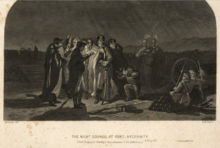
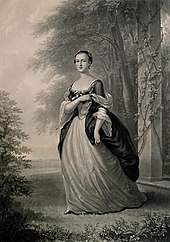

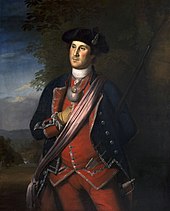
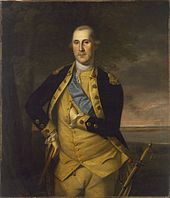
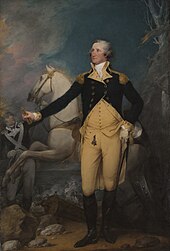


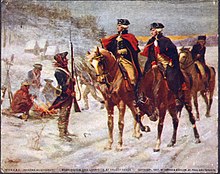

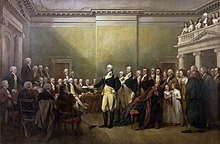
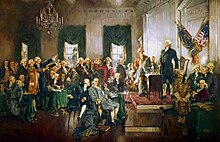








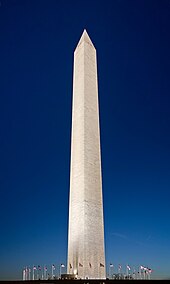
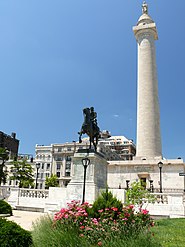


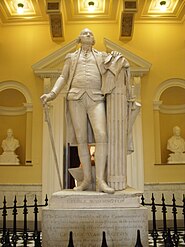
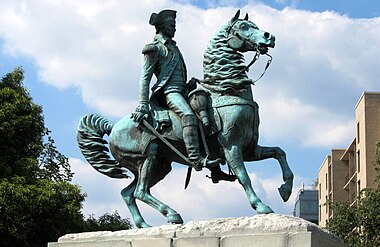
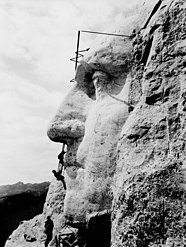















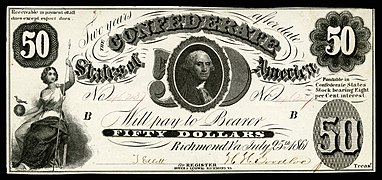
No comments:
Post a Comment